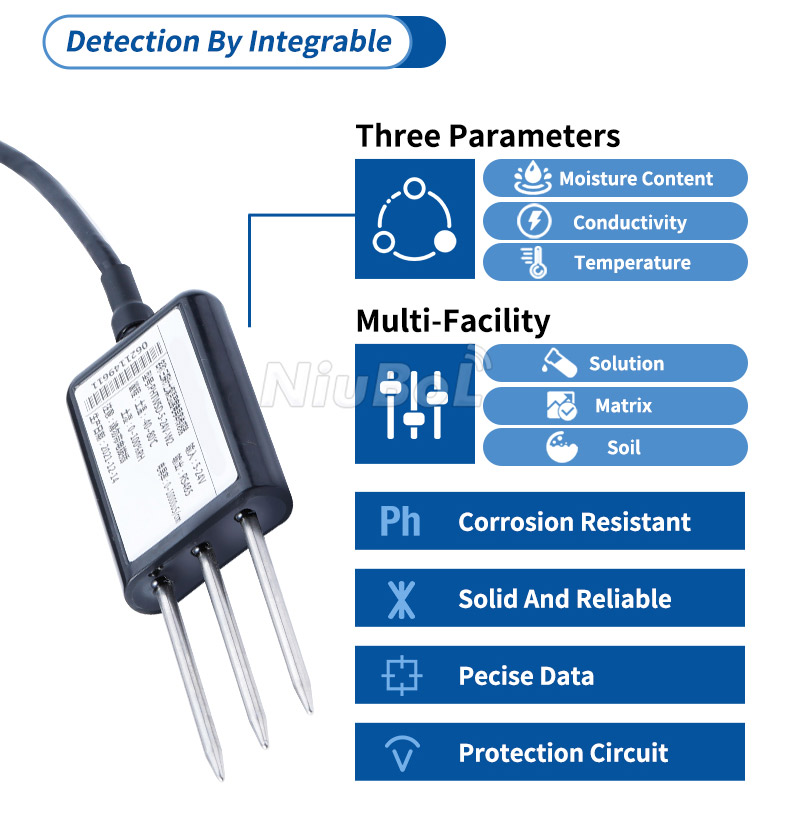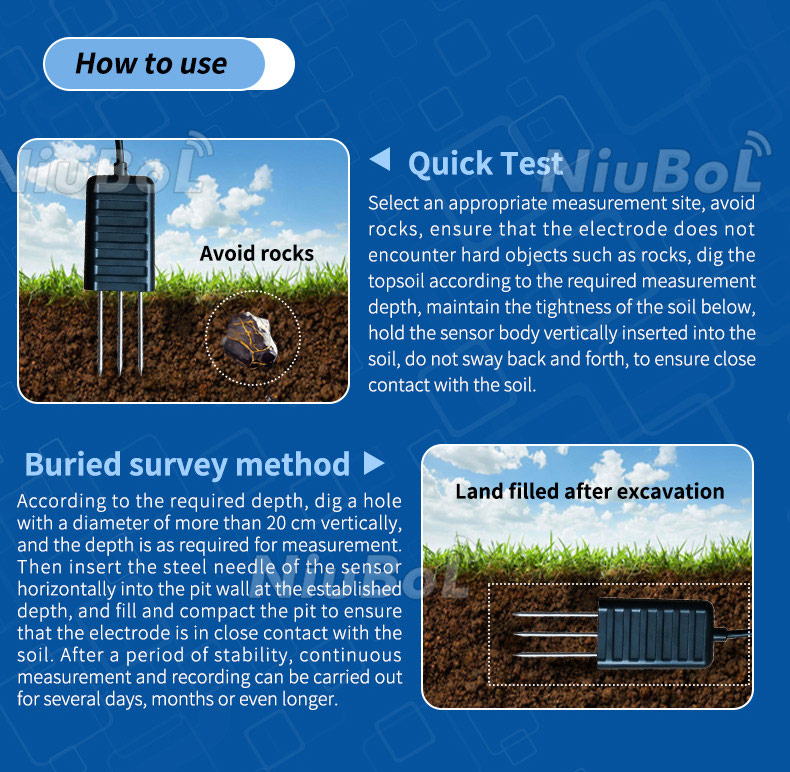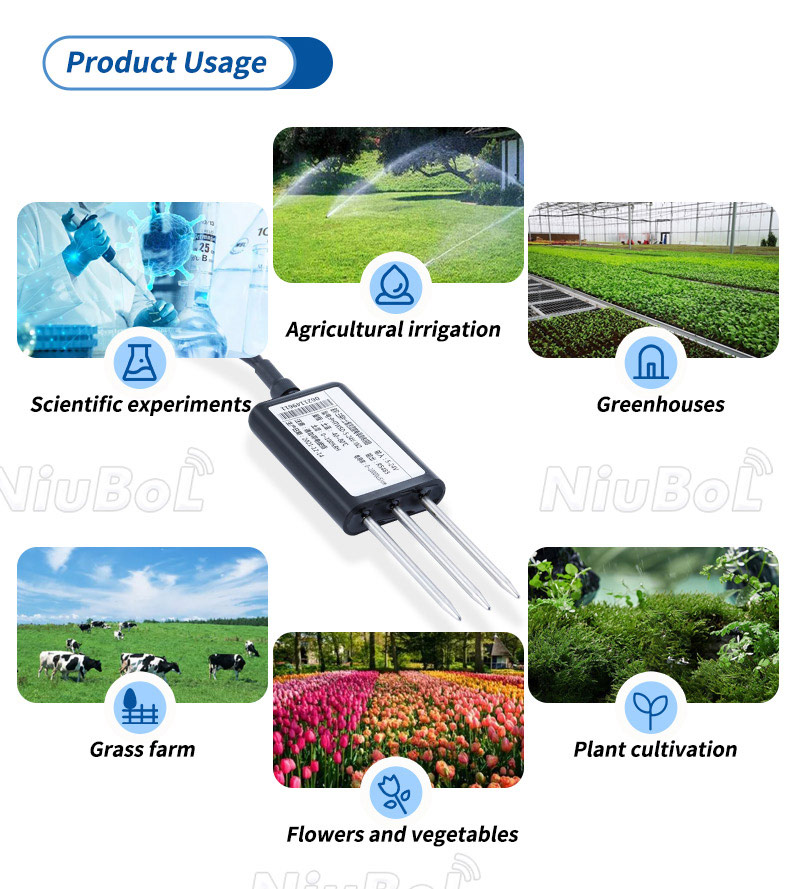

— Blogs —
—Products—
 Consumer hotline +8618073152920
Consumer hotline +8618073152920 WhatsApp:+8615367865107
Address:Room 102, District D, Houhu Industrial Park, Yuelu District, Changsha City, Hunan Province, China
Product knowledge
Time:2024-10-27 16:19:01 Popularity:555
Agricultural soil moisture sensor is an important tool for monitoring soil moisture content, which is of great significance for precision agriculture, water-saving irrigation and improving crop yield. It mainly determines soil moisture by measuring the soil's dielectric constant, resistance, capacitance and other physical parameters. Common measurement principles include:
- Principle: Determine the dielectric constant of the soil by measuring the frequency of electromagnetic wave propagation in the soil, and thus calculate the moisture content of the soil.
- Characteristics: Applicable to a wide range of soil types, relatively low cost, fast measurement speed. 2.
- Principle: Use the reflection time of electromagnetic pulse in the soil to measure the dielectric constant of the soil, and then get the humidity of the soil.
- Characteristics: high accuracy, suitable for complex soil environment, but the cost of equipment is high.
- Principle: Determine the moisture content of the soil by measuring the electrical resistance of the moisture in the soil. The higher the moisture content, the lower the resistance.
- Characteristics: Lower cost, but measurement accuracy may be affected by factors such as soil type and temperature.
- Principle: Measurement of soil moisture is based on the property that the capacitance value of the soil varies with humidity. A moisture-sensitive capacitor is usually used as the sensitive element of the sensor.
- Characteristics: High sensitivity and stability, applicable to a wide range of soil types.
1. High accuracy measurement: Based on advanced technology such as frequency domain reflectance (FDR), it can accurately measure the volumetric water content of soil and provide real-time data.
2. Multifunctionality: Not only can it measure moisture, some models can also monitor soil temperature, salinity and conductivity at the same time, providing data for comprehensive analysis of the soil environment.
3. Adaptable: compact design, good sealing, corrosion resistance, suitable for direct burial in different types of soil, not affected by soil quality, widely used.
4. Intelligent interconnection: support a variety of data output methods (such as voltage type, current type, RS485), easy to integrate with the data acquisition system or cloud platform to realize remote monitoring.
5. Ease of use: easy to operate, easy to carry, easy to install and maintain, some are also equipped with color LCD screen, intuitive display of data, support QR code reading.
6. Low power consumption design: built-in energy-saving measures, suitable for long-term field deployment, reducing maintenance frequency.
7. Environmental adaptability: wide range of operating temperatures, can work stably in extreme weather conditions, storage conditions adaptability.
- Purpose: Optimize irrigation schedules by monitoring soil moisture in real time to reduce water waste and improve crop yield and quality.
- Advantages: Avoid over or under irrigation, save water resources and improve irrigation efficiency.
- Uses: In agrometeorological monitoring, soil moisture data help predict droughts and floods and support drought and flood control.
- Advantage: Timely preventive measures are taken to reduce disaster losses.
- Purpose: To adjust irrigation strategies to ensure that crops are grown under optimal moisture conditions, e.g. to control sweetness in vineyards.
- Advantages: Improve crop yield and quality and reduce disease incidence.
- Purpose: To provide accurate moisture data for the advancement of agricultural science in soil science and plant physiology research.
- Advantages: Provides reliable data for scientific research and promotes agricultural technology.
- Purpose: To assess the impact of soil moisture on ecosystems and support research on environmental change.
- Advantages: Protect the ecological environment and promote sustainable development.
- Purpose: Integrate with automated irrigation systems as part of smart agricultural systems to realize automated management.
- Advantages: Improve the intelligence of agricultural production and reduce manual intervention.

- Method: The sensor monitors the soil moisture content in real time and irrigates according to the actual needs of the crop.
- Effect: Avoid excessive or insufficient water supply, ensure that water is supplied to the crop root system in just the right place, and reduce the waste of water.
- Methods: When integrated with the irrigation system, the sensor can automatically trigger the irrigation equipment to initiate irrigation when the soil moisture is below a preset threshold.
- Effect: Realize automatic adjustment of water, reduce manual intervention and improve irrigation efficiency.
- Methods: Avoid blind irrigation and reduce water loss through evaporation and seepage by precise measurement.
- Effect: Contribute to water savings while reducing negative environmental impacts such as surface runoff and salinization risks.
- Methods: Maintains soil moisture in the optimal range for healthy crop growth.
- Effect: Improve photosynthetic efficiency, increase yields and improve crop quality.
- Methods: Intelligent monitoring to avoid over-irrigation and reduce the occurrence of diseases.
- Effect: Reduce the use of pesticides and lower production costs.
- Purpose: Long-term monitoring of soil moisture changes to help predict droughts and floods.
- Advantages: Provide data support for disaster management and timely preventive measures.
- Purpose: Soil moisture is a key factor in the balance of ecosystems and its changes affect biodiversity.
- Advantages: Monitoring helps to protect the natural environment and ecological balance.
- Purpose: Provides data for climate change models by analyzing long-term trends in soil moisture.
- Advantages: Understanding the effects of global warming on soil moisture and its impact on agricultural production.
- Purpose: Soil moisture is closely linked to the surface and groundwater cycles, and monitoring prevents water pollution due to over-irrigation.
- Advantages: Reduces leakage of fertilizers and pesticides and protects water quality.
- Purpose: Changes in soil moisture are early indicators of land degradation (e.g. desertification).
- Advantages: Monitoring facilitates timely restoration measures.
- Purpose: Used in urban greening projects to optimize irrigation of public green spaces.
- Advantages: conserves water resources and maintains the aesthetics of the landscape.
- Purpose: To study the water requirements of different crops and the effect of soil moisture on the growth cycle of crops.
- Advantages: Provide a scientific basis for sustainable agricultural development.
- Suggestion: Choose a sensor with high accuracy and stability to ensure the accuracy of measurement results.
- Suggestion: Choose the appropriate measuring range according to the actual needs, to ensure that the sensor can cover the required range of soil moisture content.
- Suggestion: Choose the sensor with better durability to adapt to the harsh agricultural environment.
- Recommendation: Ensure that the sensor is compatible with devices such as data collectors or data loggers for real-time recording, storing and exporting of data.

- It is recommended that the sensor be installed in a location that is representative and reflects the overall moisture condition of the soil, and avoid installing it in an area that is too dry or too wet.
- It is recommended that the sensor be cleaned and maintained regularly to ensure that its surface is clean and not covered with debris to improve measurement accuracy.
- It is recommended that the sensor be calibrated and verified periodically to ensure the accuracy of its measurement results.
- Suggestion: Export the measurement data to computer for storage and processing in time for subsequent analysis and research.

Through these applications, soil moisture sensors not only enhance the efficiency and quality of agricultural production, but also play a key role in environmental protection and sustainable utilization of natural resources. We hope these detailed descriptions are helpful to you! If you have any other questions or need further information, please feel free to contact us.
1.NBL-S-THR Soil Temperature Moisture Sensor datasheet
NBL-S-THR-Soil-temperature-and-moisture-sensors-Instruction-Manual-V4.0.pdf
2. NBL-S-TMC Soil Temperature Moisture EC Sensor datasheet
NBL-S-TMC-Soil-temperature-and-moisture-conductivity-sensor.pdf
3. NBL-S-TM Soil Temperature Moisture Sensor datasheet
NBL-S-TM-Soil-temperature-and-moisture-sensor-Instruction-Manual-4.0.pdf
4. NBL-S-TMCS Soil Temperature, Moisture, Conductivity and Salinity Integrated Sensor
NBL-S-TMCS-Soil-Temperature-Humidity-Conductivity-and-Salinity-Sensor.pdf
5. NBL-S-TMCS-7 Soil Temperature, Moisture, NPK, Conductivity and pH Integrated Sensor
7-in-1-Soil-Composite-Sensor-Manual.pdf
4. NBL-S-TMCS-8 Soil Temperature, Moisture, NPK, pH, Conductivity and Salinity Integrated Sensor
Related recommendations
Sensors & Weather Stations Catalog
Agriculture Sensors and Weather Stations Catalog-NiuBoL.pdf
Weather Stations Catalog-NiuBoL.pdf
Related products
 Combined air temperature and relative humidity sensor
Combined air temperature and relative humidity sensor Soil Moisture Temperature sensor for irrigation
Soil Moisture Temperature sensor for irrigation Soil pH sensor RS485 soil Testing instrument soil ph meter for agriculture
Soil pH sensor RS485 soil Testing instrument soil ph meter for agriculture Wind Speed sensor Output Modbus/RS485/Analog/0-5V/4-20mA
Wind Speed sensor Output Modbus/RS485/Analog/0-5V/4-20mA Tipping bucket rain gauge for weather monitoring auto rainfall sensor RS485/Outdoor/stainless steel
Tipping bucket rain gauge for weather monitoring auto rainfall sensor RS485/Outdoor/stainless steel Pyranometer Solar Radiation Sensor 4-20mA/RS485
Pyranometer Solar Radiation Sensor 4-20mA/RS485
Screenshot, WhatsApp to identify the QR code
WhatsApp number:+8615367865107
(Click on WhatsApp to copy and add friends)